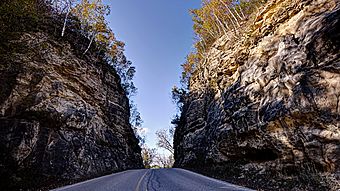Mindoro Cut facts for kids
Quick facts for kids |
|
|
Mindoro Cut
|
|

Looking north
|
|
| Lua error in Module:Location_map at line 420: attempt to index field 'wikibase' (a nil value). | |
| Location | CTH C, bet. Mindoro and West Salem, Town of Farmington, Wisconsin |
|---|---|
| Built | 1908 |
| Architect | Miller, Louis A. |
| NRHP reference No. | 07000428 |
| Added to NRHP | May 15, 2007 |
Mindoro Cut is a special road section in La Crosse County, Wisconsin. It's like a deep trench cut through Phillips Ridge. This cut helps County Trunk Highway C connect the towns of Mindoro and West Salem.
The Mindoro Cut is 74 feet (23 m) deep. It is also 86 feet (26 m) long and 25 feet (7.6 m) wide. It is known as the second-deepest cut ever built by hand in the Western Hemisphere. It's also the oldest hand-built cut that is still used today without major changes. Workers started building it in 1907 and finished in 1908. They mostly used hand tools for this big project. The Mindoro Cut was added to the National Register of Historic Places in 2007. This means it is a very important historical site.
Building the Mindoro Cut: A Historic Project
Farmers from Mindoro and officials from La Crosse County wanted the Mindoro Cut built. It was part of a movement to create better roads. The goal was to link a creamery in Mindoro with a train station in West Salem. Before the cut, Phillips Ridge was too steep for wagons and cars. People had to take a much longer route around the ridge.
Work on the cut began in 1907. Most of the digging was done with hand tools. Workers also used dynamite to break up hard rock. Planners first thought the ridge was only soft sandstone. But they soon found out the inside of the ridge was hard dolomite rock. This made the work much harder.
Horses could not work well on the steep slopes. So, workers had to remove the broken rock using wheelbarrows. They balanced these wheelbarrows on narrow, uneven planks. Louis Miller was the project supervisor. He would fire workers who dropped their wheelbarrow three times. Many workers reportedly quit after their very first load. Workers earned $1.25 each day. They bought their meals from a cook shanty right at the work site.
The project was finished in 1908. The total cost was $11,241.29. This was reportedly a loss for the contractors who built it. In 1920, the highway through the cut was paved. Guardrails were also put in place for safety. The Mindoro Cut has not been changed since then. It was added to the Wisconsin State Register of Historic Places in October 2006. Then, it joined the National Register of Historic Places on May 15, 2007.

